Are Pro Setups For Everyone? Riding Dan Atherton’s GT Sanction
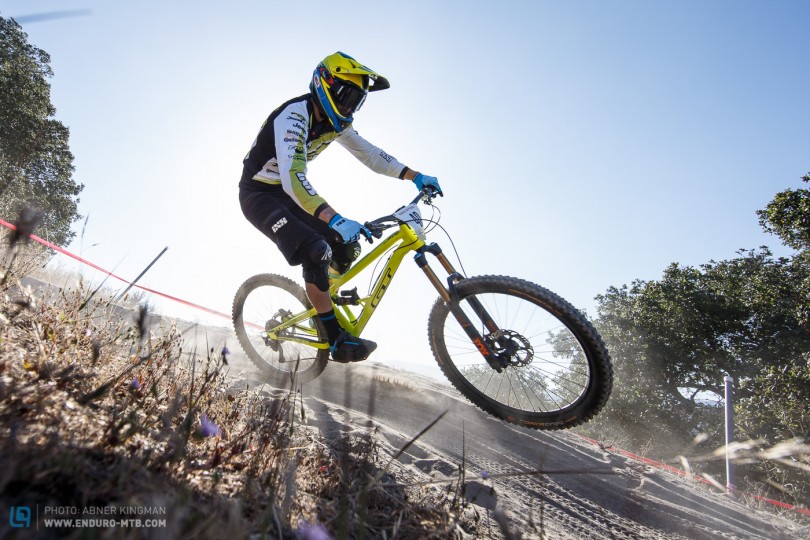
At Sea Otter this year Dan Atherton attacked an awkward double jump on the downhill course with aggression and precision. He picked the bike up over a leading bump, pressed it down before the lip of the jump and sailed all the way into a rutted out sand berm, which he railed without slowing. Atherton made the maneuver look effortless despite the blurring speed at which he approached it. Having just ridden the same feature on a nearly identical GT Sanction (a bike which Dan helped design), I tried to imagine approaching it the way Dan did, but there was a disconnect. I could see clearly what he did, but I could not form a mental image in which I managed to do the same thing. On my runs I was rolling through the middle of the gap jump and braking before the corner, nothing like what Dan was doing.
I became aware as I stood in a cloud of dust watching him disappear down the course that there is a vast gulf between Dan and me. Every weekend many of us climb aboard bikes that closely resemble those of the Enduro World Series pros, and ride trails much like the ones they race on, but there is a difference. The top pros are both athletically gifted and riding hard at the ragged edge of control. The only chance they have of winning is to push their bodies and equipment to the breaking point, often crossing the line. I am neither coordinated enough nor willing to ride like that, and standing on the side of the course at Sea Otter I was left wondering how it is possible that the same equipment is even appropriate for riders as different as Dan and me.

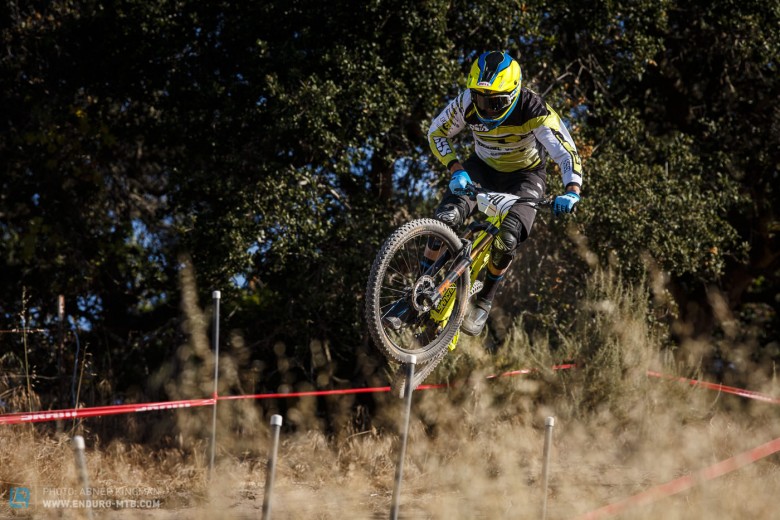
Back in the GT pits Dan made a sincere effort to bridge the gap. Behind the display of bikes and the mechanics’ trailer, seemingly miles away from the swarms of people packing the sun-baked aisles of the show, we sat in the shade of a tent beside a pond. With the help of pen and paper Dan explained how he was riding the feature, “You pick up your front wheel here and wheelie up on top. And then as your front wheel hits, your back wheel soaks this one up. Then you pretty much jump off your front wheel and just let your back wheel follow.”
Dan is intense, but also observant and polite. He noticed the skeptical expression on my face and diplomatically added, “It’s quite technical to do it that way, so it’s cool if you can’t do it.” We both started laughing as the absurdity of the exchange became clear. At 33, Atherton is one of the most recognizable figures in the world of mountain biking. Having competed at the top level of several disciplines for more than 15 years, he stands out for his dedication, fearlessness, and competitive drive. In 2010 he shattered his C1 vertebra as well as fracturing his C2 and skull, but after a few months in a Halo neck brace he was riding hard again. At 46, I am an eager but inexperienced trail rider, with a healthy respect for the consequences of a broken bone, and did not have a single race under my belt. Dan would have trouble counting the number of days he has worn a full-face helmet or gap jumps he has launched. I had never ridden with a full-face helmet or attempted a gap jump. But here we are about to race the same course, on the same bike, outfitted with the same suspension.
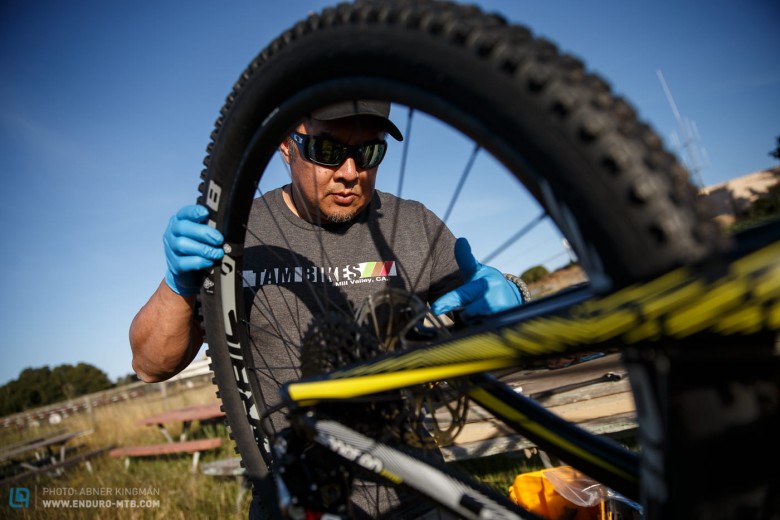
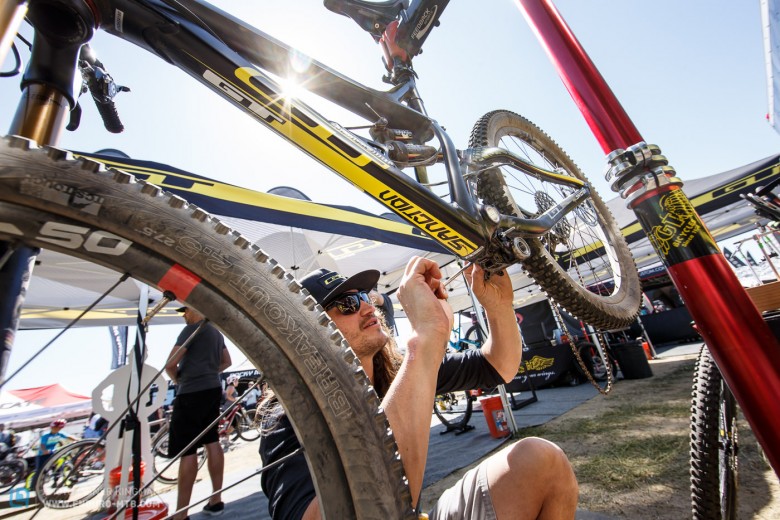
What we each experienced on the bike could not have been more different. His pace was nearly half again what mine was, and the forces of landing and corning at those speeds tax the suspension exponentially more. How is it possible that the same 2016 Fox 36 fork is an appropriate tool for both of us?
The Fox 36 with the RC2 damper allows for external tuning of low and high speed compression, and low speed rebound, while high speed rebound is set internally at the factory. Fox must decide how broad the range of adjustment should be and where to center it. Ariel Lindsley, who works in R&D and product management at Fox, says that choosing the midpoint is always a challenge, “We let everybody at Fox test, from the fastest guy to the slowest guy, and then you kind of hash it out and find a happy place in the middle.” He says that the older Fox 36 fork may have skewed slightly toward the more aggressive rider. The newer tune opens up the lower end a bit for riders like me, while still accommodating more aggressive riders. Additionally, for 2016, the high speed rebound has been revamped to make the 36 a little more forgiving. Lindsley said, “We felt like there was some harshness in the fork. What we found was our high speed rebound ports got a little bit choked on big, deep-stroke hits. It felt pretty good because it made your bike feel glued to the ground, but on repetitive, high-speed hits it wasn’t reactive enough. So we went to a larger kidney port size in the rebound piston, and then used more shims (to regulate oil flow).”
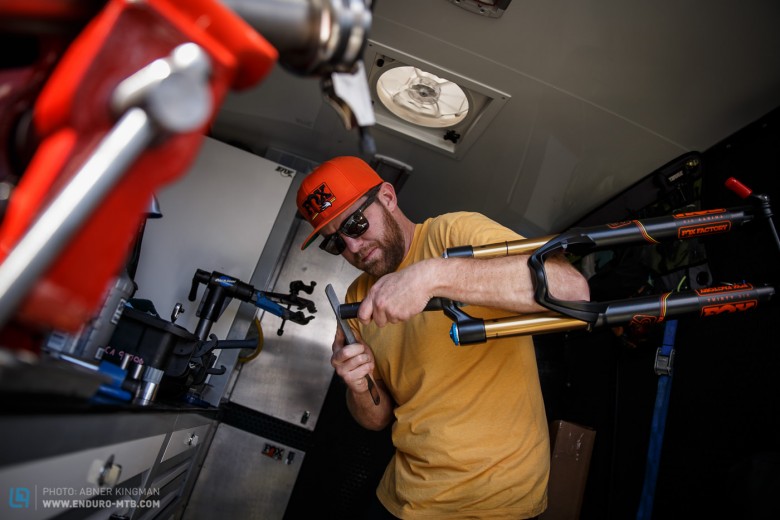

Dan Atherton is part of the Fox RAD (Racing Application Development) program, which gives him access to custom tuning and modifications, but Lindsley says that while pro enduro racers in the program might be testing something new or receiving a custom refinement, they are almost never asking for a tune that would put them outside the normal range of adjustability.
I asked Dan about how he was adjusting his fork, “I guess in a nutshell I’m always trying to get it to be as supportive as possible, but keep the suppleness off the top end. Something I really like in suspension is when it returns to the top of it’s stroke, or at least where I have my sag. To do that I run a little bit more low speed (compression damping), but at the same time, to keep that suppleness on the high speed bumps, a little less high speed (compression damping).”
What about the balance between front and rear? “I usually run slightly softer on the rear. I kind of like to sit into the bike a bit. And with the Sanction it’s got quite a lot of travel on the back, so you can afford to run a little bit more sag, to get a little bit more negative travel, to give you a bit more grip. I don’t mind bottoming out. I think that’s quite important on an enduro bike. I think with a downhill bike you want to be bottoming out a few times, but with an enduro bike because you only have a hundred and fifty, sixty, seventy mil travel, I think it’s important to use your legs a lot and your body. If you’re never blowing through your travel it’s going to be so firm, that shock, that you’re not going to have much off the top.”
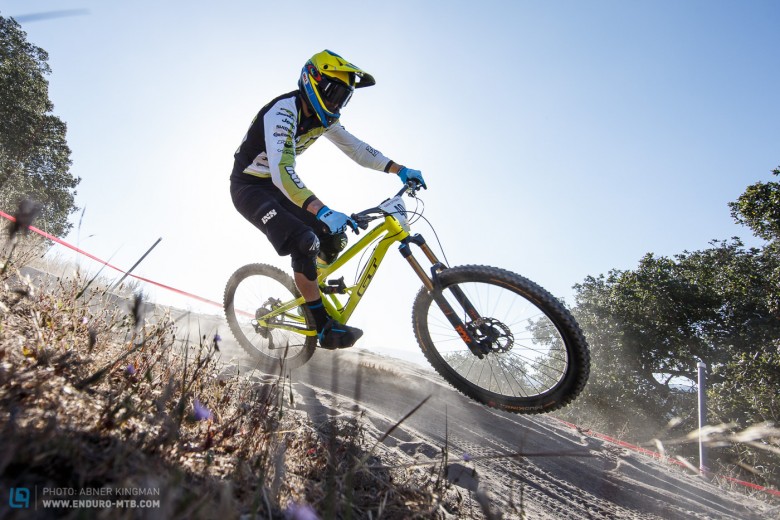
With Dan’s advice in mind, and with some additional help from the suspension tuning experts at Fox, and the GT mechanics, I found settings that seemed to suit me well on the track at Sea Otter. Then afterwards, over the course of a month, I refined those settings further on trails that I’m more familiar with. The combination of the Sanction’s stability at speed and the suspension have allowed me to ride far faster over rough terrain than I had ever considered possible. But, that’s only fast by my standards. I started wondering what it would be like if I rode my local trails with Dan’s settings. Maybe I could ride even faster, or maybe I couldn’t even hold on to the bike.
After adjusting air pressure proportionally to body weight, I dialed in Dan’s settings. My settings skew toward one end of the spectrum and his toward the other, but we both have a number of clicks of adjustment remaining. Dan says that he doesn’t think extreme settings are appropriate for enduro racing, “I think most of the guys run pretty standard settings. I guess some of the guys go a little stiff on their forks. But you’d probably see more of a difference in downhill with how stiff the guys run their bikes compared to the public. With enduro bikes it would be a bit more normal because of how long you’ve got to ride them.”
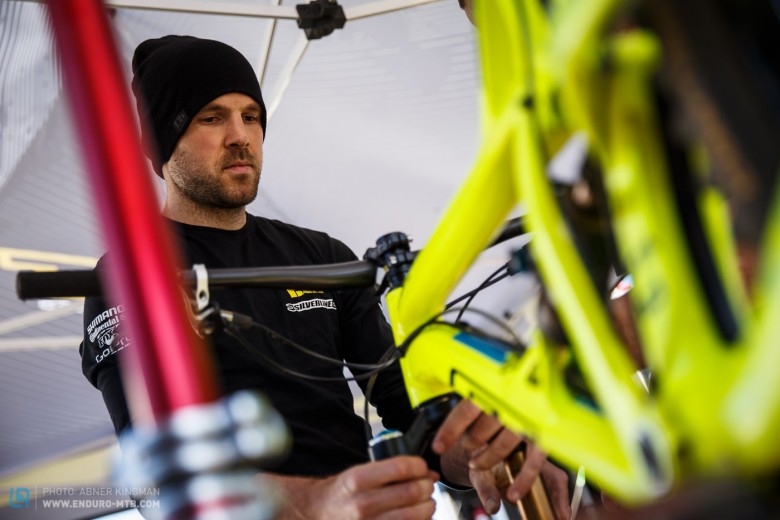
At first, his settings did in fact feel extreme to me. The fork was so stiff that it seemed to be sliding out in the corners and every rock was knocking me off line. Would it help if I went faster? I gradually ramped up, until I had completely departed my comfort zone (something the Sanction seems to wholeheartedly endorse), and there, at a pace I knew my limited skill could not sustain, riding faster than I ever had, I found Dan Atherton’s settings started to make sense. The bike was gracefully absorbing bit hits at high speed. At the bottom I caught my breath and immediately returned my settings to their previous values. I will not tempt fate by riding like that again, and Dan can have his settings to himself.
The lesson was clear. Suspension tuning is all about speed over terrain. Take the same rider, on the same bike, on the same terrain and there is a suspension tune that is appropriate to the speed they are riding. Alternately, for a rider who tackles every trail at the fastest possible speed, there is a suspension tune that is appropriate to the particular trail. Dan says that he has developed a habit of dialing in settings unique to each stage of an enduro race, “I do it in practice, so I remember where I need to be for each stage. It’s hard when you get to the top of a stage and you’ve got five, seven minutes before you race and you have to remember to eat your food, drink, put your kneepads on, clean your goggles, drop your seatpost, and on top of that you’ve got to remember your suspension settings.”
On race day at Sea Otter I was not pressed for time, waiting in line at the start gate under the baking sun for more than an hour, but still nearly forgot to pull my goggles down. After I left the gate, I told myself several times to slow down, because my heart was already racing with adrenaline and I did not want to pass out, or explode. Once I settled in, though, I started to enjoy the riding. It didn’t matter if Dan Atherton and I were from different planets, or if he launched every jump that I rolled through. I was having a great time riding a bike exactly like his. The joy of riding a good, well-tuned bike is universal.
Words & Photos: Abner Kingman
Did you enjoy this article? If so, we would be stoked if you decide to support us with a monthly contribution. By becoming a supporter of ENDURO, you will help secure a sustainable future for high-quality mountain bike journalism. Click here to learn more.








